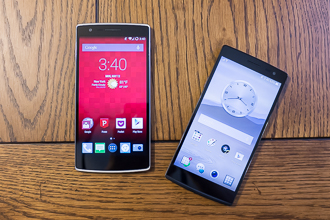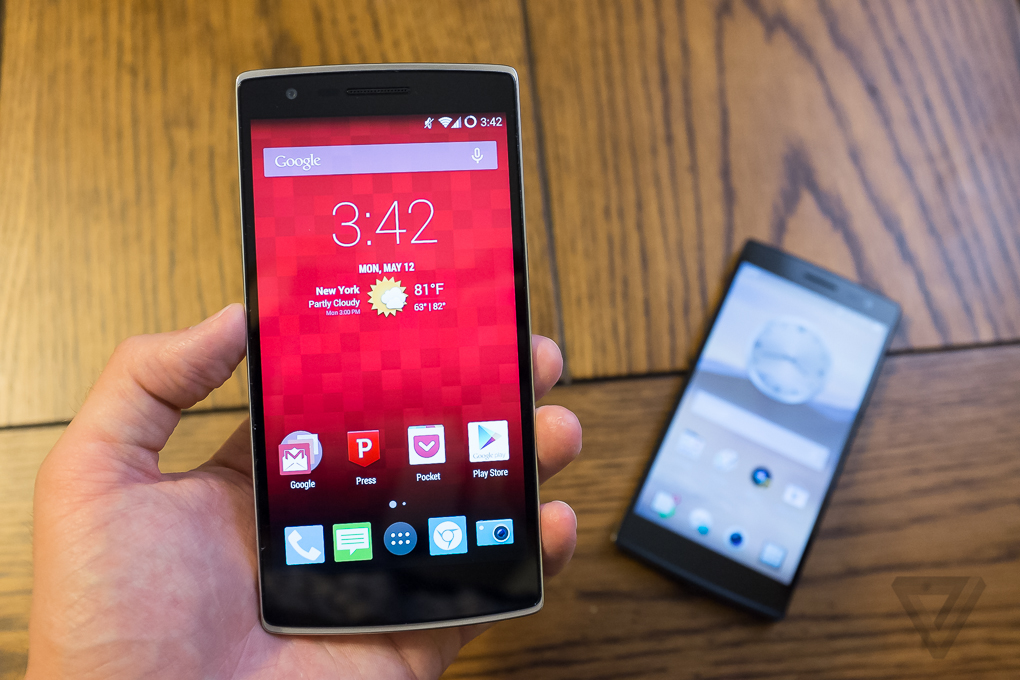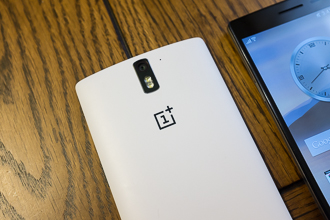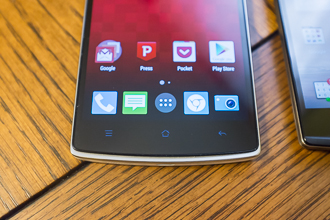Chances are, the smartphone in your hand or pocket was designed by a company based in America, Korea, or maybe Taiwan. Most consumers have probably never even looked at or considered a smartphone from a Chinese company.
Companies like Huawei and ZTE have tried for years to break in to the high-end markets in the US and Europe without much success. Lenovo decided that it would just be easier to buy Motorola than make a go at the US alone. Meanwhile, upstart Xiaomi has garnered a lot of attention and press, but it has yet to bring its wares outside of Asia.
Oppo is a lesser-known name, but it claims to be the “second-most profitable mobile phone company” in China. Now Oppo and its recent offshoot OnePlus are taking a different approach to bringing that success out of China and conquering the West. Instead of partnering up with carriers and kowtowing to their demands, both companies are selling their latest phones, unlocked, directly to consumers. The $499 Oppo Find 7a and $299 OnePlus One offer competitive, high-end performance at prices significantly lower than other, better-known smartphones. Google has taken a similar approach with its Nexus line of smartphones, but those are designed primarily as vehicles for the latest version of Android. Oppo and OnePlus are just focused on selling a lot of phones across the globe.
With the Find 7a and One, the two companies should have no trouble doing just that. And they might just change the expectations we have of smartphones we purchase.
For some, Oppo will be best known as the company that launched the first smartphone with CyanogenMod, the N1. However, the company has been building phones for the Chinese market since 2008, following a stint with dedicated MP3 players. Oppo has three different lines of smartphones in China, from entry-level models up to high-end variants, but it is still far from a household name in the US and Europe. The Find 7a is a variant of a Chinese-specific phone tuned specifically for Western networks, and is the company’s best effort yet at attracting customers outside of the mainland.


OnePlus' goal is to provide everyone with "access to the best and latest technology"
OnePlus is closely related to Oppo. It was founded by a former Oppo vice president and is owned by the same parent company, BBK Electronics. BBK is almost like a Chinese electronics version of General Motors: it owns numerous brands that appear to compete with one another, but all benefit from increased access to components, research and development, and factories.
OnePlus founder Pete Lau has said his goal is to provide everyone with "access to the best and latest technology," not just those that can afford high-end, expensive smartphones. OnePlus’ first smartphone, the One, makes good on that claim: it’s packed with high-end specs but costs less than half of competing high-end smartphones. It’s clear that OnePlus is leaning on BBK’s existing relationships with component manufacturers to source its high-end parts for the One. There’s no question how OnePlus is able to sell the phone for so little: Lau has said that OnePlus is selling the phone at cost, forgoing all profits on the hardware itself. This indicates that BBK or Oppo is subsidizing it out of the gate, but it’s not clear how long a business model like this will last.
The close ties between Oppo and OnePlus can also be seen in the smartphones that the companies have produced. The Find 7a and OnePlus One are virtually identical in terms of hardware and design. In fact, apart from a few relocated buttons and minor variances in specs, the only difference between the two phones is the software that they run.

Both the Find 7a and the One have 5.5-inch, 1080p displays that look great and offer wide viewing angles. As a result, both are too big to use with one hand. They both could be brighter as well — it can be difficult to see them outdoors. Both phones are powered by one of Qualcomm’s modern quad-core processors (the same processor found in HTC’s new One and Samsung’s Galaxy S5) paired with 2GB (Find 7a) or 3GB (One) of RAM. Both have big batteries that can last all day and then some, and both have 13-megapixel cameras that are competitive with other high-end Android phones you can buy today. The cameras won't give the iPhone 5S or Lumia 1020 anything to worry about, but they are comparable to the cameras on a high-end Samsung or HTC phone. (The Find 7a includes a gimmicky "50-megapixel" mode that stitches multiple, standard size images together into one monster file, but it doesn't work that well and is not a reason you should buy a phone.)
The designs of the phones are impressive as well: both feature matte plastics that feel nice in your hand and have solid builds without any creakiness or obvious cheapness to them. In fact, I’d say that either the Find 7a or the One have better and more attractive designs than the Galaxy S5 or LG’s G2.
Both the Find 7a and the One are better looking than the Galaxy S5 or LG's G2
The only real problem I had with the Find 7a and One (apart from their too-big dimensions) are the capacitive buttons below the displays — they are too dimly lit and nearly impossible to see outdoors. But if you thought you had to spend three-quarters of a thousand dollars to get a smartphone with top-end hardware and build quality, the Find 7a and OnePlus One prove that you don’t. It used to be that only the most expensive smartphones had the best hardware, but these phones from Oppo and OnePlus are using the same processors and many similar components as HTC and Samsung’s high-end phones.

Since their hardware is so similar, the phones’ main differences are found in the software. Oppo’s Find 7a runs Android 4.3 with a custom interface, which the company calls Color OS. Much like Samsung’s TouchWiz or HTC’s Sense, Color OS touches almost every aspect of the operating system with Oppo’s customizations. Many times it feels a bit heavy-handed and unnecessary, and in today’s flat design obsessed industry, the gradients and textures used throughout Color OS look decidedly last decade. But the interface is fast and responsive and it doesn’t ever feel like Oppo’s customizations slow the Find 7a down.


Conversely, the OnePlus One comes loaded with CyanogenMod, just like the Oppo N1. CyanogenMod offers a lightly-tweaked version of Android 4.4 that preserves much of "stock" look and feel of Google’s operating system. Originally developed by tinkerers in online Android modding communities, CyanogenMod has matured into a fast, reliable, and attractive operating system. There are more customizable features available, and the OnePlus One comes with a different lock screen, but for the most part, it’s the same software experience you get on Google’s own Nexus 5 smartphone. Unsurprisingly, the OnePlus One’s high-end hardware has no issue handling everyday tasks and the interface is fluid and responsive throughout.
Neither phone has special software to make better use of its big display
Neither the software on the Find 7a or the OnePlus One does much to take advantage of the large screens on the devices. You won’t find split-screen modes or support for styluses, nor are there options to "shrink" the interface for easier one-handed use. But you also won’t find any carrier bloatware or garbage that can’t be uninstalled (a benefit of the fact that the Find 7a and OnePlus One are sold direct to consumers, bypassing carriers altogether).
The One changes expectations for what a cheap phone provides, but it comes at a signfiicant cost to OnePlus
At $499 and $299 unlocked, respectively, both the Oppo Find 7a and the OnePlus One undercut competitors like the Samsung Galaxy S5 and the HTC One by a significant margin. (Between the two, the OnePlus One’s much lower price and friendlier software makes it the more attractive option, considering the hardware is basically the same.) They both offer high-end experiences and impressive build quality that rivals or surpasses their more expensive competitors. My time spent using them in the past few weeks has taught me that perhaps I don’t need to spend almost a thousand dollars for a cutting-edge smartphone (provided the maker is willing to forgo profits on the device, of course). If you're looking to buy a smartphone for under $400, I can't think of a better option than the OnePlus One, and that includes Google's Nexus 5.
But that doesn’t mean Oppo and OnePlus will have an easy time breaking into the mainstream markets in America and other western countries. WIthout the support of carriers and their massive marketing machines, most people outside of the Android smartphone enthusiast community will likely never even know that the Find 7a and OnePlus One exist. HTC’s struggles in recent years have proven that marketing may be the most important factor in selling smartphones today, and carriers are a huge part of that. OnePlus’ plan to pass up profits on the hardware itself is a risky maneuver, especially since the One doesn’t have any cloud services that buyers can pay for after the fact.
Then there’s the question of buying a smartphone sight-unseen from a manufacturer you’ve never heard of. The vast majority of Americans still purchase their smartphones at carrier stores and generally choose the phone recommended to them by the sales rep. Questions also remain about support and if something goes wrong: what happens if my Oppo or OnePlus One stops working? It’s not like I can just walk into an Apple store or my local carrier store to get a replacement.
Still, with more and more carriers offering incentives for buying phones at full price and not signing a contract, companies like Oppo and OnePlus are poised to be attractive options for those looking to save money but not compromise on experience. It’s something that smartphone buyers in Europe have known for years, but we’re just figuring out here in the U.S. It will be really interesting to see what OnePlus’ next phone is like and if it will have a smaller, more manageable size that’s more popular in America than in China. If OnePlus’ grand experiment is successful, it could signify the beginning of the end of the carrier store and how many people buy their smartphones today. It could also significantly shake up the status quo of what we expect from a sub-$300 smartphone.
After all, with the OnePlus One costing nearly $400 less than a comparable smartphone from Samsung or HTC, which would you choose?
Lead photo by Sean O'Kane.
The Oppo Find 7a undercuts competitors from Samsung and HTC by a good amount while still providing a high-end experience
At $499 and $299 unlocked, respectively, both the Oppo Find 7a and the OnePlus One undercut competitors like the Samsung Galaxy S5 and the HTC One by a significant margin. (Between the two, the OnePlus One’s much lower price and friendlier software makes it the more attractive option, considering the hardware is basically the same.) They both offer high-end experiences and impressive build quality that rivals or surpasses their more expensive competitors. My time spent using them in the past few weeks has taught me that perhaps I don’t need to spend almost a thousand dollars for a cutting-edge smartphone (provided the maker is willing to forgo profits on the device, of course). If you're looking to buy a smartphone for under $400, I can't think of a better option than the OnePlus One, and that includes Google's Nexus 5.
But that doesn’t mean Oppo and OnePlus will have an easy time breaking into the mainstream markets in America and other western countries. WIthout the support of carriers and their massive marketing machines, most people outside of the Android smartphone enthusiast community will likely never even know that the Find 7a and OnePlus One exist. HTC’s struggles in recent years have proven that marketing may be the most important factor in selling smartphones today, and carriers are a huge part of that. OnePlus’ plan to pass up profits on the hardware itself is a risky maneuver, especially since the One doesn’t have any cloud services that buyers can pay for after the fact.
Then there’s the question of buying a smartphone sight-unseen from a manufacturer you’ve never heard of. The vast majority of Americans still purchase their smartphones at carrier stores and generally choose the phone recommended to them by the sales rep. Questions also remain about support and if something goes wrong: what happens if my Oppo or OnePlus One stops working? It’s not like I can just walk into an Apple store or my local carrier store to get a replacement.
Still, with more and more carriers offering incentives for buying phones at full price and not signing a contract, companies like Oppo and OnePlus are poised to be attractive options for those looking to save money but not compromise on experience. It’s something that smartphone buyers in Europe have known for years, but we’re just figuring out here in the U.S. It will be really interesting to see what OnePlus’ next phone is like and if it will have a smaller, more manageable size that’s more popular in America than in China. If OnePlus’ grand experiment is successful, it could signify the beginning of the end of the carrier store and how many people buy their smartphones today. It could also significantly shake up the status quo of what we expect from a sub-$300 smartphone.
After all, with the OnePlus One costing nearly $400 less than a comparable smartphone from Samsung or HTC, which would you choose?
Lead photo by Sean O'Kane.
:format(webp)/cdn.vox-cdn.com/uploads/chorus_asset/file/13063169/chinaphones1_1020.0.1410921378.jpg)
:format(webp)/cdn.vox-cdn.com/uploads/chorus_asset/file/13063169/chinaphones1_1020.0.1410921378.jpg)
Share this story